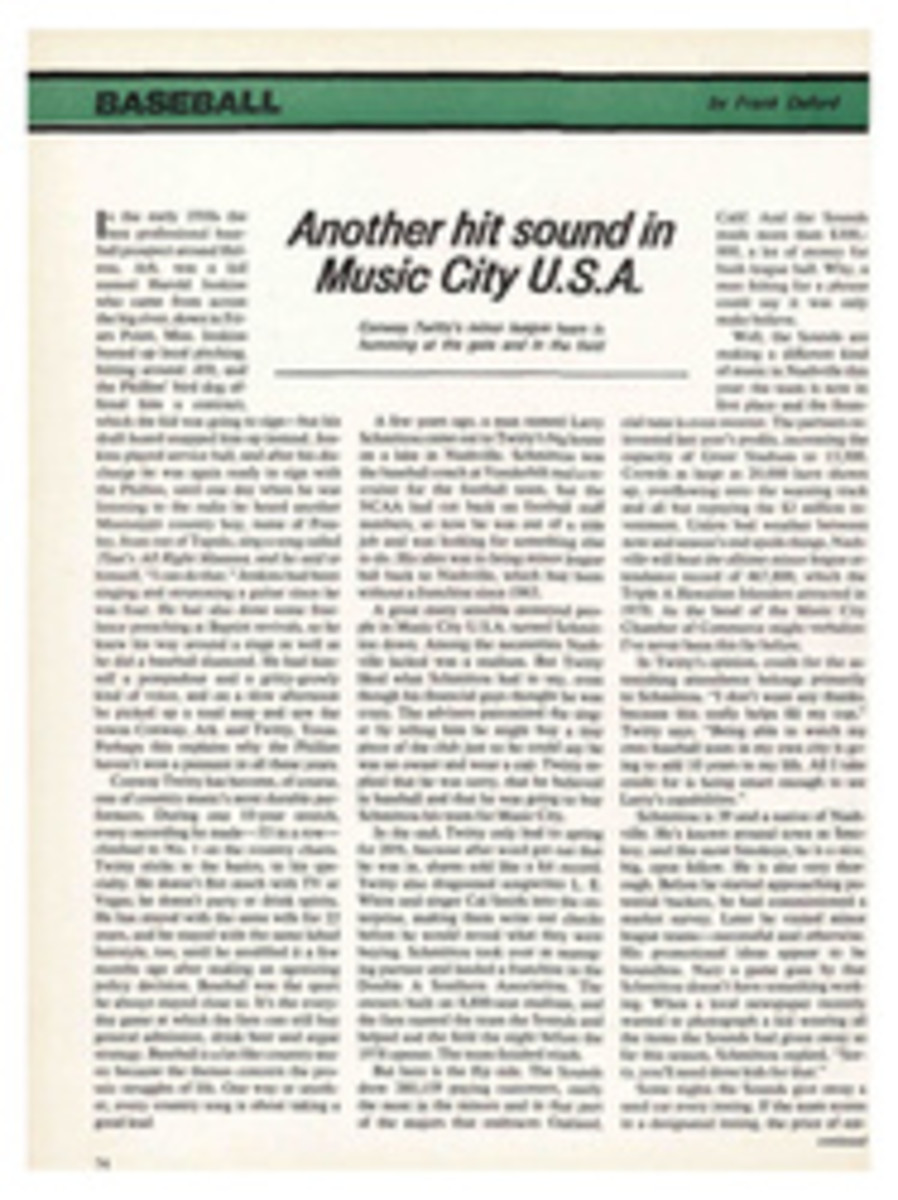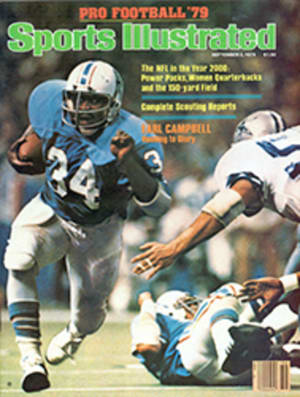
NFC Central
Can a team win a division title with a losing record? In the NFC Central, that's a definite possibility. Last season no NFC Central team scored more points than it allowed, and MINNESOTA won an NFL record-tying sixth straight division title despite an 8-7-1 record. But now Fran Tarkenton, who quarterbacked the Vikings to those six championships, has retired and the race is on.
Tarkenton's designated successor in Minnesota is Tommy Kramer, the strong-armed Rice alumnus who was the Vikes' first draft choice in 1977; Kramer did well in several 1977 appearances but last season spent most of his time wearing a headset and watching Tarkenton run for his life. Coach Bud Grant hopes Kramer's long-range passing ability will open up the Minnesota offense in a way Tarkenton could not. The Vikings have two excellent deep threats in Sammy White and Ahmad Rashad, but Tarkenton's favorite target last season was Running Back Rickey Young, who led the NFL with 88 catches.
What the Viking offense needs more than ICBMs, however, is a good ground attack. Last year Minnesota was dead last in the NFL in rushing. Injuries along the offensive line didn't help. All the wounded seem fully recovered, but now the Vikings must cope with the retirement of All-Pro Center Mick Tingelhoff; Grant thinks Tingelhoff, who started 260 straight games over the last 17 seasons, may well have been the team's MVP in '78. Dennis Swilley will try to replace him. The running game will be immeasurably improved if Chuck Foreman, slowed last year by a hyper-extended knee, returns to form; Foreman averaged only 3.2 yards a rush and failed to gain 1,000 yards for the first time in four years. As a precaution, the Vikes used their No. 1 draft pick to take North Carolina State's Ted Brown, who has the quickness Minnesota backs have always lacked.
Critics contend that the Vikings have become long in the tooth, but team officials dispute that charge, pointing out that they have replaced aging stars with good young draft picks. James (Duck) White and Mark Mullaney have taken the defensive line jobs long held by Alan Page and Carl Eller, both of whom have moved to other teams, and Randy Holloway should soon terminate Defensive End Jim Marshall's magnificent streak. Marshall has started all 254 games the Vikings have played. Holloway, Mullaney and White are all former first-round draft picks, but they hardly worry quarterbacks with their alleged pass rush.
So this should be the CHICAGO Bears' year, although their projected 8-8 record could hardly be called sensational. Still, in the NFC Central, 8-8 may well be vintage stuff. After a 9-5 season put them in the playoffs in 1977, the Bears slipped to 7-9 last year. One shortcoming was a lack of interceptions, which was attributed to a poor pass rush. The midseason acquisition of former Viking Page, who went on to lead the Bears with 11½ sacks, was a plus. Then Chicago drafted a pair of 6'5" defensive linemen, Dan Hampton of Arkansas and Al Harris of Arizona State, high in the first round. The return of Allan Ellis, a Pro Bowl cornerback in 1977 who missed all last season with an injured right knee, should help in the interception department.
Interceptions also plagued the Chicago offense. The Bears would like to throw as many touchdown passes as interceptions in 1979, a modest enough goal for most teams, but not for Chicago, which threw 28 passes away while scoring only seven times through the air. Bob Avellini and Mike Phipps split the quarterbacking in '78, but now the situation has become even more unsettled with the emergence of a third man, USC's Vince Evans. Evans is more mobile and has a stronger arm than either Avellini or Phipps; until this preseason, however, he had never shown the ability to throw with touch.
Of course, Bear quarterbacks really don't have to pass all that much. With Walter Payton and Roland Harper in the backfield, Chicago has run the ball more than any NFL team. Last season Payton gained 1,395 yards to lead the NFC in rushing for the third straight year. He often ran behind the blocking of Harper, who also rushed for 992 yards. And despite all that running, the Bears lost only eight fumbles—the fewest in the league. Still, the Bears' rushing was less productive—157.9 yards per game—than it was in 1977, when they averaged more than 200 yards.
In search of the new Bart Starr, GREEN BAY has wasted, among other things, four first-round draft choices, four seconds and five thirds. And there's still no sign of a new Starr, although Coach Bart thinks that 24-year-old David Whitehurst, a 1977 eighth-round pick who threw 10 TD passes last season, may become a dependable and, better yet, winning quarterback.
Whitehurst might attain those goals this season—if Green Bay comes up with an improved ground game. Terdell Middleton, a speedy halfback, gained 1,116 yards in '78; unfortunately, he was a one-man gang, because none of the Packer fullbacks could outrun a turtle. To remedy this, Green Bay drafted Georgia Tech's 6'1", 210-pound Eddie Lee Ivery in the first round. Last year Ivery set an NCAA single-game rushing record of 356 yards against Air Force. Both backs should be helped by the return of the Pack's best blocker, Tackle Mark Koncar, who missed last season with a knee injry. If Whitehurst gets enough protection, he has a dandy deep threat in James Lofton, who caught 46 passes for an average gain of 17.7 yards.
The Green Bay defense is vulnerable up the middle, but that is the only tactic opponents can confidently employ against the Gang Green. Ends Ezra Johnson and Mike Butler, both first-round draft choices in 1977, combined for 32 sacks last season. The Packer secondary allows plenty of short completions but almost never gets burned deep.
Developing a powerful running attack is also a top priority in DETROIT. Last year, behind a young and revamped offensive line, the Lions proved they could move the ball on the ground—sometimes. Dexter Bussey rushed for 924 yards, the second-highest total ever by a Lion back. Too often, however, Detroit was forced to go to the air, and the inexperienced line allowed a woeful 47 sacks. Veteran Quarterback Greg Landry was eventually replaced by the younger and more mobile Gary Danielson, who proved so effective—he threw for 2,294 yards and 18 TDs—that Landry was traded to Baltimore in the off-season. But Danielson had a knee operation last week, and Detroit now has a quarterback problem.
So, the Lions may stay mainly on the ground with Bussey and Horace King. The running game also should be bolstered by first-round draft choice Keith Dorney, a 6'5", 265-pound tackle from Penn State. Coach Monte Clark calls Dorney the best offensive-line prospect he has ever seen. In the third round, Clark took 225-pound Bo Robinson, who broke Mercury Morris' and Duane Thomas' rushing records at West Texas State. If the offense can get within striking distance, Detroit can usually count on three points; inside 40 yards, Benny Ricardo led the NFC in '78 with 16 field goals in 18 tries.
Alas, the Lion defense will make life difficult for the Lion offense. Detroit surrendered 300 points in '78. Led by the defensive rookie of the year, Al (Bubba) Baker, the Lions' Silver Rush ranked second with 55 sacks, but the line-backing is weak and those good pass rushers don't stop the run very well. The Lions also were frequently burned by long passes, so Clark is moving speedy Cornerback James Hunter to free safety.
If TAMPA BAY had scored 21 points a game in 1978, it would have won 13 games—not five. Hoping to increase the Buccaneers' point production, Coach John McKay will call all the plays this season. In the past McKay wouldn't have had much of a variety to call; he put so much emphasis on the running attack that in its three seasons Tampa Bay never developed a passing game. At least the Buccaneers now have someone who can go deep, in the person of second-round draft choice Gordon Jones of Pittsburgh. And, fortunately for McKay, Quarterback Doug Williams is strong enough to ward off most of the masses that regularly overrun the Bucs' pitiful pass blockers, although last year Williams suffered a broken jaw when he was sacked. Williams has the range and accuracy of an M-16, but he throws the ball too hard—one reason that he completed only 37.6% of his passes. He must still learn to dump the ball off to his backs more deftly.
The best receiver among the Tampa Bay running backs is Jerry Eckwood, a third-round draftee from Arkansas. He should see a lot of action alongside Ricky Bell, who could be a 1,000-yard runner if he can get through a season uninjured; in his first two years in the NFL, Bell missed seven of 30 games. The Bucks hope Outland Trophy winner Greg Roberts of Oklahoma will fill a hole at right guard and former Defensive End Charley Hannah—John's kid brother—will do the same at right tackle.
No NFL team stops the run better than the Buccaneers, who use a 3-4 defense. Outside Linebacker David Lewis consistently shuts down opponents' righthanded running attacks; on the other side, Lee Roy Selmon is probably the best defensive end in the NFL.
ILLUSTRATION
Brown: A speedster for the Vikings.
ILLUSTRATION
Dorney: A mauler for the Lions.
Predicted Finish
CHICAGO 8-8
DETROIT 7-9
GREEN BAY 7-9
MINNESOTA 6-10
TAMPA BAY 6-10

